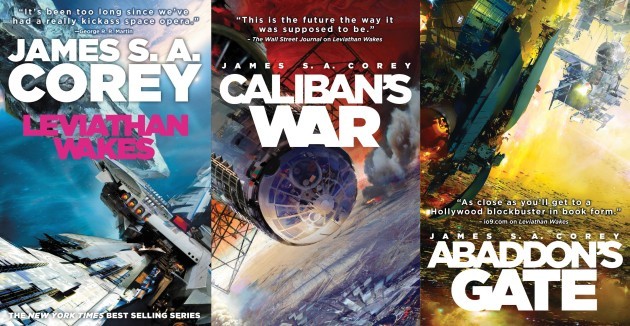The Expanse: Leviathan Wakes (2011), Caliban’s War (2012), Abaddon’s Gate (2013), Cibola Burn (2014). James S.A. Corey, Orbit Books. (8 out of 10)
Even though I consider myself a science fiction fan, it’s only been relatively recently that I’ve started reading actual sci-fi. I’ve read a ton (possibly literally) of Star Trek and Star Wars tie-in novels, but I don’t count that. Those are books about families of characters; for the most part they start an adventure, they have the adventure, and the characters can’t change or grow very much, because they all need to be available for the next installment. A friend recommended “The Expanse” book series to me in 2011, when the first book “Leviathan Wakes” was published. Three others followed and have all been high quality – “Caliban’s War,” “Abaddon’s Gate,” and the most recent release, 2014’s “Cibola Burn.”
“The Expanse” is set nearly a thousand years in the future. Earth is still around, and mankind has colonized the moon, Mars, the asteroid belt, and moons of some outer planets. Politics divide the worlds; Mars has its own government, the “Belters” from the asteroid usually side with them, but Earth and the Outer Planets Alliance are typically at odds with each other and everyone else. It’s a complex political world, which I personally find appealing. Into this mix you have Captain James Holden, his first officer Naomi Nagata, the pilot Alex, and the engineer Amos. Early in the book, their ship is destroyed, but they commandeer a Martian warship and name it Rocinante, after Don Quixote’s horse. Holden and his crew end up in the midst of interplanetary politics, along with a cop named Miller. Together they need to stop a war, find a missing girl, and try to communicate with an alien lifeform that may or may not destroy all life in the solar system.

Each subsequent book has taken the crew of the Rocinante a little further from home, and deepened their involvement in exploration, in politics, and in war. The discovery of the aliens in the first book leads to more mysteries, and getting those mysteries solved opens the universe up even more.
“Cibola Burn,” fourth in the series, has the Rocinante as an escort ship to colony ships bringing settlers and supplies to a new world. The world is already occupied by squatters, who don’t want a legitimate government presence–and even more, don’t want a huge corporation taking over their lithium mines and towns. It’s a story that’s been told before, but author(s) James S.A. Corey tell it well. The new characters add layers to the familiar ones, and no one emerges from the story unscathed. The science fiction-osity of the planet is intriguing, fulfilling that other series mandate of exploring “strange new worlds, seeking out new life and new civilizations”…but in a more brutal way than Star Trek ever portrayed. There are cataclysms, there are death slugs, there are H.R. Giger-esque machines, there are living clouds. We also see the worst and the best of humanity, sometimes in the same place.
…a more brutal way than Star Trek ever did.
The best way to describe the flavor of this series is that it’s a lot like “Firefly.” I’m not a Browncoat by any means–I enjoyed the show, but it’s not one I rewatch religiously. The crew of the Rocinante reminds me a lot of the crew of the Serenity, and even though the ship itself is described very differently, the spirit is the same. Jim Holden is a little bit cowboy, Naomi a lot Zoe Washburn. That’s how I picture them when I’m reading, and that’s not a bad thing.
James S.A. Corey is the pseudonym for Daniel Abraham and Ty Franck, who have worked with George R.R. Martin on “Game of Thrones,” and who wrote a Star Wars novel “Honor Among Thieves,” published in 2014. Their publishers just announced an additional five books in The Expanse series, and SyFy is producing a television series based on “The Expanse” in 2015. It’s good. You should read it. You’ll be glad you did.